Smell Map Narratives of Place—Paris
by Kate McLean
published November 2014
Introduction:
Human olfactory experience and perception of cities is often shared at the source of the smell but diverse in the places to which those smells transport the smeller. This note investigates the role of smell in our city experience with a specific focus on personal links formed among smell, location, and emotion. In 2010 I created a virtual dérive of bottled smells and a traditional map (with a deliberately limited visual lexicon) and then elicited and recorded visitor responses (Map 1). I selected the map as a theoretical psychogeography framework and as a visual device to geo-spatially locate a collection of odours.
Would the sense of smell conjure involuntary memories, relocating sniffers from one place to another location altogether? I asked the visitors to wander through a variety of city locations by smelling one or more smells that I captured and bottled. I theorised that this would open up a new world where cities worldwide are linked through individual experiences rekindled through smell memories, creating a new map.
As a sensory researcher and designer, I am interested in communicating links between sensory perception and urban environments in the form of sensory maps, stimulating and provoking emotional connections with place, inspired by the more playful approaches of psychogeography. I investigate how smell, in particular, can be used to comprehend our immediate environment and to generate memories of a specific place. As a creator of six smell maps, with a further two maps currently underway, I exhibit the interactive, participatory installations internationally in galleries, museums, festivals, and visitor centres. The works ask the viewer to ascribe their personal associations to the selected, representative scents for each of the cities, and to note individual smell associations on single sticky notes. I discovered during the course of my research that these smell notes frequently form their own micro-narratives of smell perception.
The initial research was in response to a call for a small exhibition to showcase the range of MFA visual communication research projects at Edinburgh College of Art where I was studying. I had a limited time frame of fourteen days for research, development, design, and installation. The secondary stage of this project (Map 2) was to find a way to communicate and present the sticky notes resulting from the initial exhibition. The overall process can be summarised thus:

Brief Contextualizations: Art Cartography as Collective Narrative:
Regarding collective narrative as a narrative written and shared by many people, this work uses a series of smells as the shared experience and the map’s conventions to stimulate memory and imagination. Map 1 provides a framework for a series of stories waiting to be told, and Map 2 reframes those stories as a series of reflections on our olfactory-stimulated memories of place. The map can therefore be understood as a “storytelling stimulator” (Caquard).
Psychogeography:
Modern psychogeography instigates a variety of artistic cartographic responses; Ingrid Burrington’s “Loneliness Map” shows missed connections between lonely individuals in New York and in doing so directly references the Situationist’s definition of psychogeography as “the study of the precise effects of geographical setting, consciously managed or not, acting directly on the mood and behaviour of the individual” ("The Library"). In 2003, “smell provocateur” Sissel Tolaas conducted extensive research with the local population to identify typical Parisian smells in each of the 20 arrondissements and then worked with perfumers to synthetically recreate 22 smells of Paris, including dog shit, metro platform—metal, tires and burned plastic, sweat and urine, fresh French cigarettes, and French bakery. As Jim Drobnick suggests, smell art has the effect of challenging any passive urban association we have for smell: “it engages assessment, thought and agency” (Diaconu). Tolaas suggests that—eventually—smells could act as an olfactory map whereby inhabitants could identify where they were by the smells. Whilst this particular work, “SIRAP mon amour,” had no geo-visual reference, Tolaas’s subsequent works, “Talking Nose–Mexico City” and “NOSOEAWE – Berlin”, both make reference to the physical boundaries using planimetric views of the cities. These maps are crowd-sourced spatio-political commentaries that reframe the cities olfactorially when exhibited.
With Scratch ‘N Sniff NYC, Nicola Twilley geo-visualised the shape of New York City using a collection of scratch and sniff circular coloured stickers on the wall. Using data from Andreas Keller’s research at the Voshall Lab to find out “how New Yorkers interact with the odorous universe,” Twilley picked a representative twelve smells to create two maps: one showing the city according to a dominant odor perception framework in each neighbourhood and the second a crowd-sourced selection of smell biases from visitors to the exhibition. In doing so, Twilley explores both the smell preferences and smell perceptions of New Yorkers and leaves room for further investigation into the personal associations “sniffers” have with the smells.
My original installation, “Smell Map Paris,” drew from this body of work. The piece had two foci; one was to use smell mapping as a modern psychogeography of “playful, inventive strategies for exploring cities” (‘A New Way’) in the form of a virtual dérive. The second was to generate personal emotional responses to individual smells that I could then analyse, determining if any particular scents evoked other specific geo-spatial destinations. The resulting body of smell notes far exceeded my expectations both in terms of quantity and the variety of personal, emotional connections with smells, memory, and location.
“Smell Map Narratives of Place—Paris” is a practice-based study seeking to make sense of the extensive body of embodied smell perceptions through the creation of a digital version of the original dérive with multiple variations. Smell notes containing smell stories are five steps removed from the original:
1. place – 2. perceived smell – 3. recreated smell – 4. smell note – 5. digital representation – 6. reader
Despite this degree of removal from the point of origin, I suggest that a digital smell-induced dérive perfectly embodies Guy Debord’s description of the derive as “a technique of rapid passage through varied ambiances” (Coverley). The cartographic framework for the “smellscape” (Porteous) serves as the platform for multiple, personal narratives. The map is the unifier of place and sensory stimuli, both in physical exhibition and in the final virtual smell walk.
Methodology:
The first step in this research was to decide on a city and then determine which smells best represent it. I chose Paris for two reasons; one, it is a city popularly known for its smells, and two, I lived in the city for two years and had access to a cross section of residents, visitors, and parts of the expatriate community. The descriptive question I was seeking responses to was, “Which smell reminds you of Paris?” I elected to use multiple methods; semi-structured face-to-face interviews, internet-based research, and limited content analysis of a piece of journalism, as well as drawing on personal recall.
During the course of the nine semi-structured interviews, many people explained symbolic associations of the smell and their personal reasons for selecting them; for example, one woman picked perfume explaining that whenever she leaves the city she takes Yves St Laurent’s “Paris” with her as a reminder of home. She indicated that she is not alone in this practice. In targeting a cross section, I collected responses from the following groups: Parisian, French, expatriate (resident), and expatriate (no longer resident). I used internet-based research as a resource in the form of social media (Facebook) to ask the same question through messaging of friends who were living or had lived in Paris during the years 2005-2007 (the same time as I lived in the city so that I could relate to, and recreate, the smells). Authenticity of responses was assured by the fact the participants were personal contacts. Internet-based research generated a further twelve responses including the smell of parquet, which was originally described as honeyed wax, the substance used to clean Parisian wooden floors. I used content-analysis of Caroline Wyatt's descriptive account of her time in Paris recognising that the account was written for some purpose “other than for the research and it is difficult or impossible to allow for the biases or distortions that this introduces” as Colin Robson highlights as a point to be aware of:
“The meaty odour of sizzling thick steaks emerges from hundreds of pavement brasseries, until the classic French cuisine of the eighth and first arrondissements gives way to the foreign smells of the fourth, where oriental spices mingle with couscous and kebabs as I near the Marais” (Wyatt).
From the Wyatt text I chose to focus on the smell of the steak. I selected fourteen scents as representative of Paris based on a combination of research and my capacity to create the smells as perfumes in the period of time available with no prior knowledge of chemistry or perfumery. I rejected the general smell of the Métro in favour of the smell of urine as one notable smell feature of the Paris métro experience, as I considered urine to be easier to recreate as a “perfume”. With my intended aim of linking smells to personal narrative, I also wanted to ensure that each smell had a mini-narrative point of origin. These original points I created as cards (fig. 1) to accompany the event, listing the smell, emotion, location, and personal narrative. In this case, the card reads “Gauloises, Excitement, Le 9 Jazz Club 11ème, Soft smoke, smouldering jazz, seductive evening.”
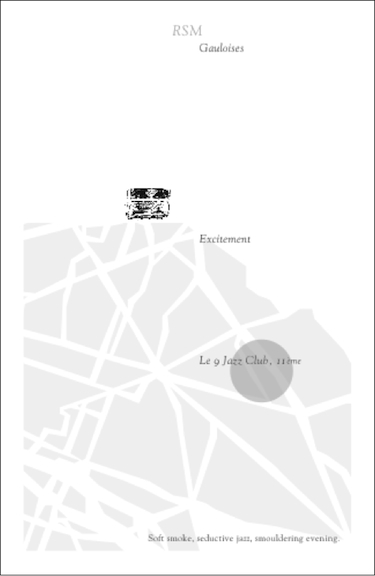
The final 14 smells I selected to represent Paris were:
1. Coffee
2. Cheese
3. Oil paints
4. Flowers
5. Perfume
6. Steak
7. Gauloises
8. Bread
9. Drains
10. Urine
11. Rain
12. Parquet
13. Musty cellars
14. Wine
The rationale for selecting fourteen scents in total was that I wanted a range of smells spread geographically across the city (fig. 2) whose smell source origins were aesthetically balanced across the map. I considered selecting one smell per arrondissement (of which there are 20) but rejected the idea so as not to symbolise a systematic synopsis of smell by administrative zoning.
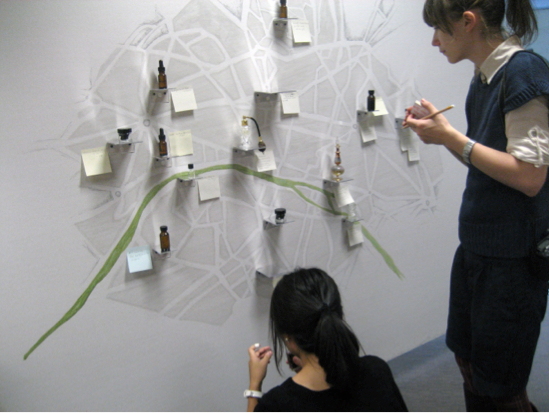
Smell Creation and Exhibition:
I created the smells using a variety of techniques (from distillation to the use of black velvet to absorb fumes) and recipes (using essential oils and alcohol), and housed them in antique perfume bottles, modern aromatherapy bottles, and glass jars (fig. 3). The bottles and jars were left deliberately unlabelled and then placed on small shelves on a 1.5m x 1m hand-drawn map of Paris, and exhibited at Edinburgh College of Art for a week during October 2010. I asked visitors to write onto sticky notes any emotions or locations brought to mind upon sniffing the smells (fig. 4). I called the event a “Paris Smell Map Virtual Dérive.”.
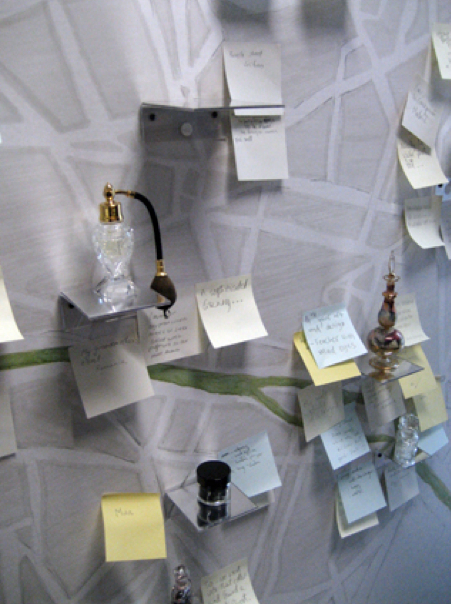
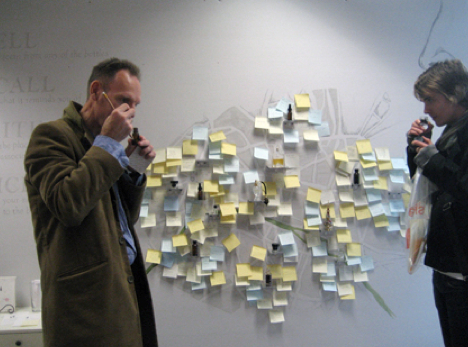
Data Analysis:
During the event I collected 532 individual smell notes. To explore the dataset, I theme-coded the smell notes according to which smell they were written about and recast to count frequency of smell being referenced:
Results:
|
|
|||||||||
|
Code (Smell Source Location) MSL (Métro Saint Lazaire) |
Smells Most Written About Urine |
20 |
|||||||
|
RCM (rue du Cherche-Midi) |
Bread |
20 |
|||||||
|
PSA (Pont de l’Alma) |
Drains |
24 |
|||||||
|
JDT (Jardin des Tuileries) |
Rain |
36 |
|||||||
|
PDT (Place du Tertre) |
Oil Paints |
36 |
|||||||
|
AVN (Avenue Niel) |
Flowers |
36 |
|||||||
|
AGV (Avenue George V) |
Perfume |
37 |
|||||||
|
HDV (Hôtel de Ville) |
Parquet |
37 |
|||||||
|
LTA (La tour d’argent) |
Musty cellars |
38 |
|||||||
|
PVH (Place Victor Hugo) |
Steak |
42 |
|||||||
|
LSC (La Coupole) |
Wine |
43 |
|||||||
|
FLB (Florent Dubois) |
Cheese |
46 |
|||||||
|
CSM (Canal Saint Martin) |
Coffee |
57 |
|||||||
|
RSM (rue Moret) |
Gauloises |
60 |
|||||||
|
Total Responses
|
532
|
||||||||
Example notes
In this study Gauloises was the most written about smell and urine the least written about. I suggest that the smell of stale smoke is easier to identify with and therefore easier to relate to. The process of recasting and familiarising myself fully with the data, transcribing, and rereading meant that I could identify further themes emerging. The smells led visitors to write about far more than just location and emotion—namely objects, people, activities, eras, events, as well as what I termed “unspecified locations” (e.g. "granny’s bedroom") and unspecified emotions such as “socks without wash for 356 days!”
Emotion: Specified (emotional vocabulary) e.g., AGV5 (fig. 5)
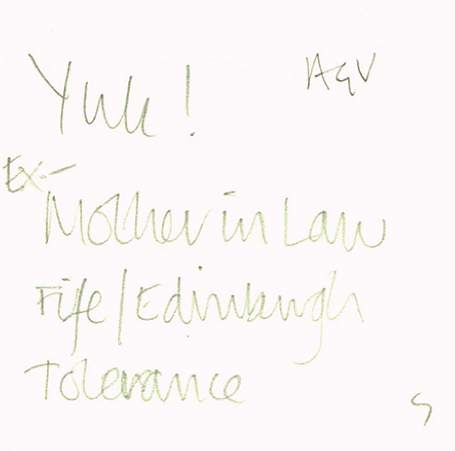
Emotion: Unspecified (inference of emotion from the narrative of the smell note) e.g., AVN5 (fig.6)
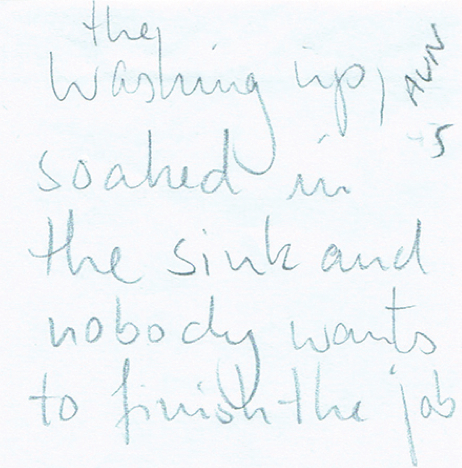
Location: Universal (identified with a place name) e.g., CSM19 (fig. 7)

Location: Personal (somewhere specific in the mind of the writer) e.g., LTA6 (fig. 8)
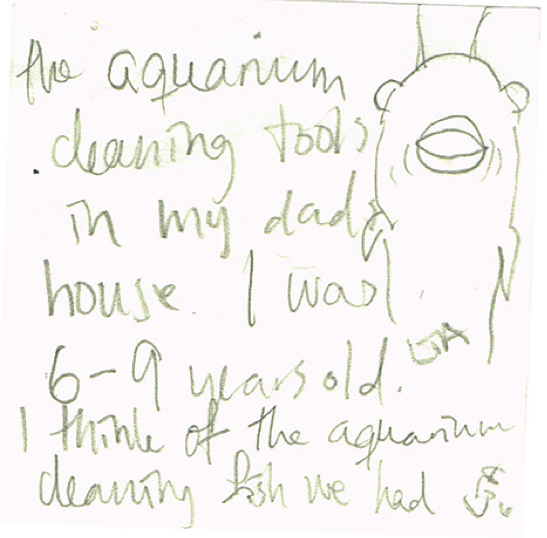
From this, I identified a single category that was most often cited for each smell and observed that perfume prompted memories of people, while coffee prompted short stories (sample section of complete analysis shown):
|
LSC (Wine) |
MSL (Urine) |
RCM (Bread) |
JDT (Rain) |
AGV (Perfume) |
|
|
Location: Personal |
6 |
1 |
2 |
8 |
4 |
|
Location: Universal |
15 |
11 |
7 |
8 |
22 |
|
Emotion: Specified |
6 |
0 |
0 |
4 |
5 |
|
Emotion: Unspecified |
22 |
8 |
10 |
13 |
16 |
|
Object |
28 |
11 |
14 |
25 |
24 |
|
Person |
6 |
0 |
5 |
10 |
16 |
|
Era/Age |
3 |
2 |
2 |
4 |
7 |
|
Activity |
10 |
2 |
3 |
4 |
2 |
|
Comment |
2 |
0 |
1 |
0 |
0 |
|
Event |
10 |
0 |
1 |
0 |
0 |
|
Other |
0 |
2 |
1 |
2 |
2 |
|
Story |
5 |
4 |
3 |
6 |
4 |
|
Total Sticky Notes |
43 |
20 |
20 |
36 |
37 |
In cataloguing and recording the stories, I observed that the “Post-It notes are laden with emotional content and as such commence new narratives of their own” (McLean). The next stage was thus to qualitatively analyse the narrative content. Appreciating that “qualitative data can easily become overwhelming” (Robson), I created a thematic map to explore trails across each of the thematic categories (e.g. personal places) using coloured wool to link smell notes in each geographical location (fig. 9).
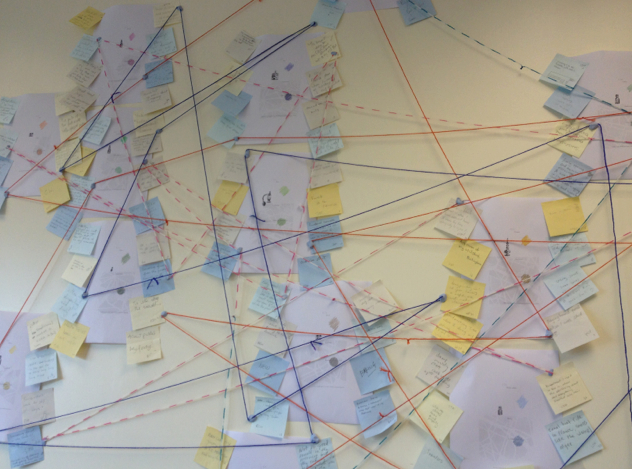
With the storylines visualised, I created six smell narratives (Appendix 1) based on three of the categories of smell association—personal location, activity, and specific emotion —looking to see if there was a cohesive narrative. Not finding any comprehensible narrative arc when the smell notes were linked in the form of a paragraph, the emotive power of individual smell notes stood out. Many are similar to the “six-word story,” as explained in the online publications “Narrative” ("Six-Word") and “Smith.” This form is often attributed, although refuted by Mikkelson and Mikkelson (‘Snopes.com), to Hemingway: “For sale: Baby shoes. Never worn.” Other examples of six-word stories include Margaret Atwood's “Longed for him. Got him. Shit.” and Janet Burroway's “All those pages in the fire.”
Data Visualisation:
My next step was to showcase these narratives in a meaningful way so that readers could interpret them whilst respecting the complexity of the dataset. Since a smell map instigated the smell stories, I decided to use the stories to enable readers to take either a virtual or real smell journey across Paris. The resulting prototype is an interactive book/app and a piece of exploratory data visualisation. It uses the smell stories as individual mini-narratives to link specific smells with named places.
I calculated possible permutations for visiting fourteen locations in Paris. In the field of mathematical combinatorics, these were specifically classified as “permutations without repetition” in which the number of choices is reduced each time by one, so that previously visited points cannot be visited again. This factorial function of fourteen! resulted in more than 87 x 109 (or 87 trillion) possible smell walks.
To give the “walker” (reader) a choice within such a large set of choices, I decided they should be able to select from themed walks based on smell perceptions. Thus, a random walk is drawn from the thematic category chosen. I created the following themes based on previous analysis of the sticky notes:
• Personal places
• Places that exist on another map
• Specific emotions
• Just a feeling
• Objects
• People
• Activity
• Events
• Another era
• Micro-tales
• A comment
• Nostalgia
• Home & family
• Nature
Diagram of Use:
Users select a theme for their walk from the list (fig. 10):
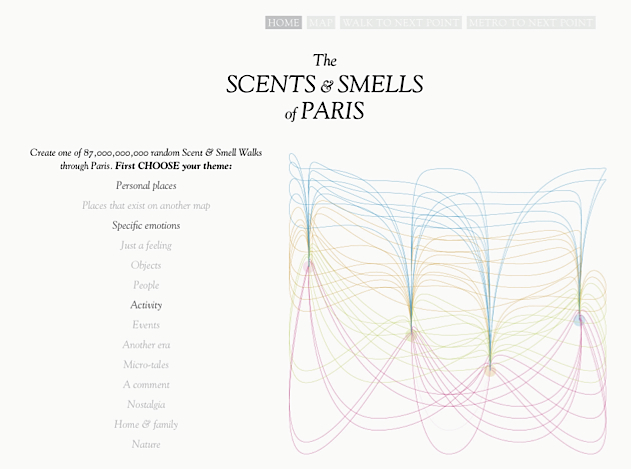
The theme selects a starting location and then calculates a route (from the 87 trillion possible), which is visualised as a path on the map (fig. 11):
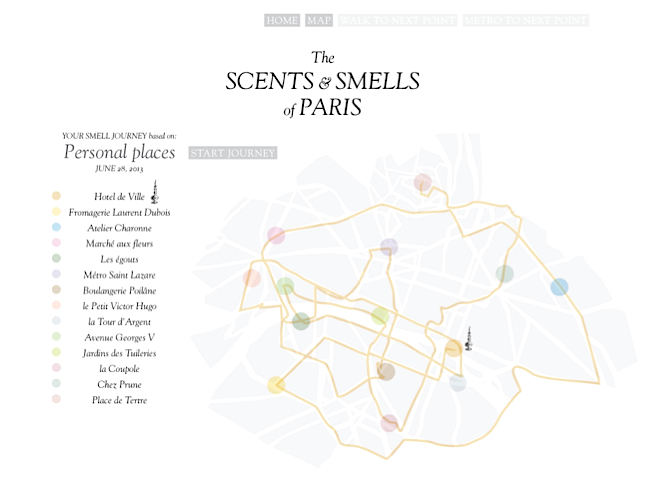
As users start their journey, they receive a smell note and a chance to imagine that smell for themselves based on the simpledefinition (in this case “parquet floors”) and/or the smell note (in this case “A new book smell, when I have arrived home and made the time specifically to open it.”) Smell notes are randomly selected from their category in the database of smell notes. Clicking the forward arrow the user experiences metaphorical rapid ambient transit to the next location of their journey around Paris (fig.12):
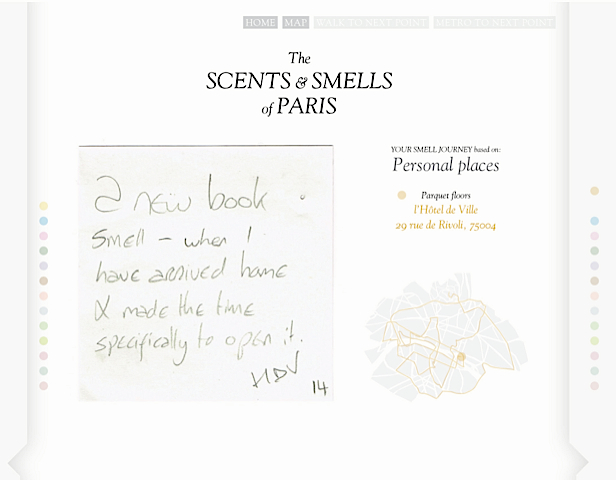
A summary narrative is presented at the end of the journey showing the trail and all the notes (fig.13):
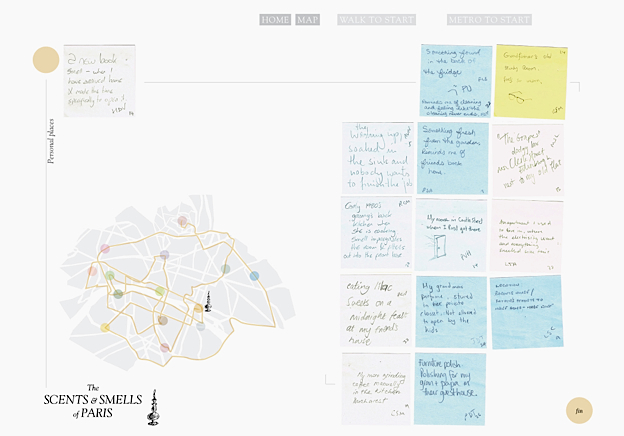
Summary Narratives:
In order to determine if the resulting collection of 14 randomly selected smell notes produces a coherent narrative sequence in readers, I then explored how they could be represented together synoptically on the page. According to Orion Kidder's theory of narrative construction in comics, 4. 4. “viewers derive aesthetic, lyric, narrative, and causal meaning from each panel specifically by its position in the sequence.” Kidder continues to reference the syntagm, a definition developed by Thierry Groensteen, the “retroactively-informed, three-panel construction” to explain how meaning is derived in comics through not just the single panel you are looking at, but through the panels on either side of it too. With this particular construction in mind, I created a portrait-oriented page with the smell notes arranged in panels of three across the page. The decision to place the initial smell note to the left side was made to provide a focal point as the conceptual start of the journey, as exemplified on the summary of each smell journey taken. The design thus is intended to serve a purpose in terms of page organisation and readability; however, my observations are that, even when combined visually in this format, the smell notes do not form a coherent new narrative arc.
Conclusion and Next Steps:
As seen in examples through this note, the smells conjured a variety of personal responses and served to relocate sniffers from the corporeal world to another very personal and internal world. The complexity of the responses was such that the simple expectation of a series of places linked by single smells (such as coffee or cheese) was naïve. In seeking solutions for summarising and explaining a complex data set I elected to use design in the form of data visualisation, using the map as a framework.
The accompanying interactive PDF indicates how the interactive book/app will function. I envisage the reader selecting a theme for their walk (in this demo there is one smell walk for each of the following themes: personal places, activities, specific emotions). A random sequence of destinations is then selected, which in turn pulls the relevant smell notes from a database. The reader can then take a virtual tour of the city through smell narratives one at a time. If the reader chooses to follow the actual route in Paris, then GPS, local transportation, and GIS data would be used to generate choices for walking or public transport between the smell points.
The resulting prototype serves as a model for representing a complex set of data, demonstrating both quantitatively and qualitatively how real and imagined places are narrated. As particular smells from specific locations led gallery visitors to recall other places from memory, so their individual narratives now enable further readers to imagine themselves on a tour of the smells of Paris. The virtual dérive wheel turns full circle. As a digital app, the prototype approximates an immersive environment, in which “immersion is the subjective impression that one is participating in a comprehensive, realistic experience” (Dede); as such, I suggest that as a digital data visualisation map this work has the capacity to conjure engagement with the smells of a journey through the use of cartography as a structure for a collective narrative full of emotionally charged personal mini-narratives of place.
Works Cited
“A New Way of Walking.” Utne. n.p., n.d. Web. 14 Oct. 2010.
Burrington, Ingrid. The Center for Missed Connections. n.p., 2009.
Caquard, Sébastien. “Cartography I: Mapping Narrative Cartography.” Progress in Human Geography 37.1(2013): 135-144. CrossRef. Web. 5 Aug. 2014.
Coverley, Merlin. Psychogeography. 2nd rev. ed. Harpenden: Pocket Essentials, 2010. Print.
Dede, Chris. “Immersive Interfaces for Engagement and Learning.” Science 323.5910 (2009): 66-69. CrossRef. Web. 12 Nov. 2013.
Diaconu, Madalina, Eva Heuberger, Ruth Mateus-Berr, and Lukas Marcel Vosicky, eds. Senses and the City: An Interdisciplinary Approach to Urban Sensescapes. Wien: LIT Verlag, 2011. Print.
Kidder, Orion. “Theories of Sequence: Narrative Construction in Comics.” Continuities and Innovations: Popular Print Culture Conference. 2008, Edmonton, Alberta (Canada). Academia.edu. Web. 2 Jun. 2013.
McLean, Kate. “Emotion, Location and the Senses: A Virtual Dérive Smell Map of Paris.” Proceedings of the 8th International Conference on Design and Emotion: Out of Control. Eds. Jamie Brasset, Paul Hekkert, Geke Ludden, Matt Malpass, and Janet McDonnell. London: Design and Emotion Society, 2012. Print.
Porteous, J. Douglas. “Smellscape.” Progress in Physical Geography 9.3 (1985): 356-378. Sage. Web. 20 Dec. 2013.
Robson, Colin. Real World Research: A Resource for Users of Social Research Methods in Applied Settings. Chichester: Wiley, 2011. Print.
“Six Word Story Guidelines.” Narrative Magazine. n.p., n.d. Web. 5 Jun. 2013.
SMITH Magazine. MagSmith, LLC., n.d. Web. 4 Jun. 2013.
“Snopes.com: Ernest Hemingway – Baby Shoes.” Urban Legends Reference Pages, 20 Oct. 2008. Web. 8 Nov. 2010.
“The Library at nothingness.org/Definitions.” n.p., n.d. Web. 20 Nov. 2013.
Tolaas, Sissel and Geza Schoen. “NoSoEaWe.” Talk to Me: Design and the Communication between People and Objects. MoMA, New York. Installation. 2011.
Tolaas, Sissel. SIRAP Mon Amour. Haus der Kulteren der Welt, Berlin. Installation. 2003.
---. Talking Nose. Video. 2009.
Twilley, Nicola. Scratch ‘N Sniff NYC. Installation. “You are Here” Exhibition, Pratt Manhattan Gallery, New York. 24 Sept.-6 Nov., 2010.
Wyatt, Caroline. “The Rich Smells of Paris.” BBC. 3 Aug. 2003. Web. 28 Oct. 2010.

